It is not just a catchy title, it is true! Everything in Varanasi is extreme: the number of people for the small area, the traffic, the dust, the noise, the cows and water buffalos on the road and their dung in every corner of every street, the bacteria on the Ganges, the number of temples, especially dedicated to Lord Shiva (the Hindu God of Destruction and Regeneration), your fear of getting sick and having to go through the horrible inhuman experience of an Indian province hospital… The list goes on and on, but for me what is most extreme and something that nowhere else in India are you in more direct frontal contact with is DEATH.
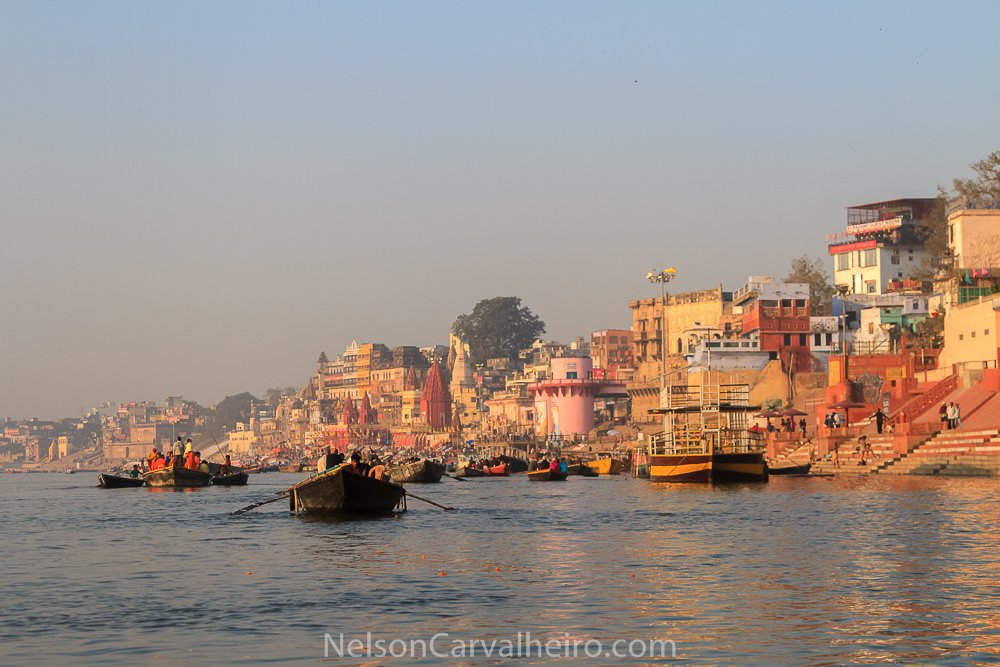
Varanasi and the Circle of Life is a story about India’s most extreme, chaotic, colorful and intense city. A place where Death is as important as Life.
Yes, Varanasi (or Banaras, as the locals call it) is known amongst Hindus as the City of Death and Rebirth in the same manner as Rishikesh is the city of birth. These two cities are connected by the river Ganges, the so-called mother of all Indians. The astonishing detail is that, although the city of Rishikesh was built at the start of the Ganges (as the river takes its shape from the streams coming downhill from the Himalayas in north India ) Varanasi was built right in the middle of the path that the Ganges, not at its end in Ganges Delta in Bangladesh.

Varanasi is one of the oldest still-inhabited settlements on earth dating back more than 5000 years. It is incredible that the ancient Hindus built their City of Death in the exact middle of the Ganges, not in the end. A direct influence of Hinduism believes that Death is not the end. It is a mere stage in the journey of the aatma (the Hindu would for inner-self or soul) to the next life until it ultimately reaches Moksha (the Hindu Nirvana).

In Hinduism it is believed that, if one practices good Karma throughout the whole of one’s life, he/she shall be rewarded in the next life, with more happiness, a better living condition, a better job, a bigger house and so on until the death/rebirth cycle is broken and Moska is achieved. On the other hand, if one practices bad Karma, his living conditions will deteriorate in the next life, up the point of this ?aatma being reborn in the body of a rat. The ultimate insult to the soul.
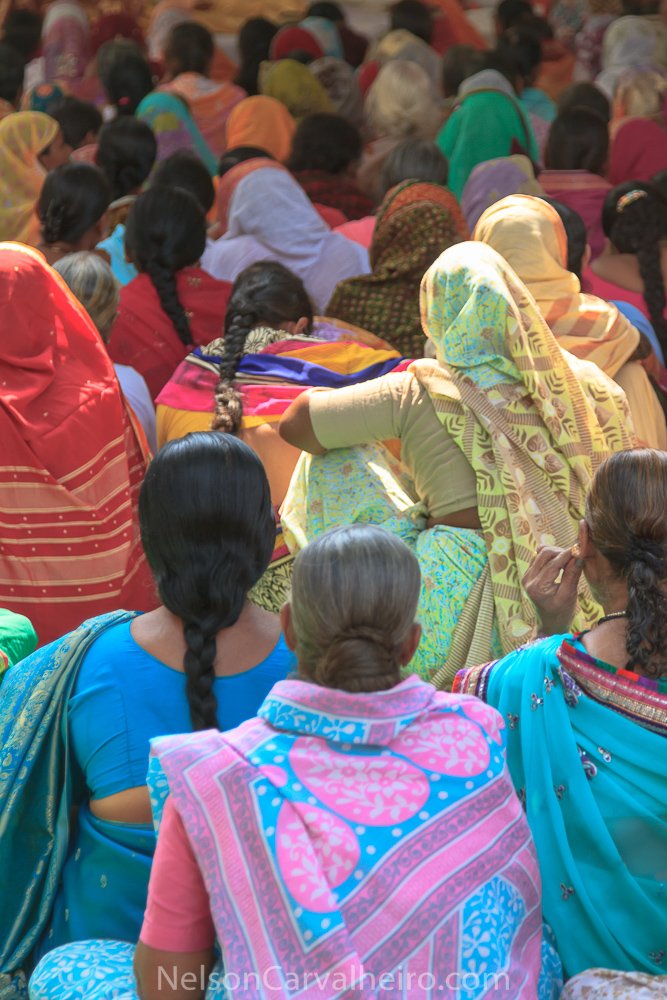
So why is Varanasi such a good place to die and to be cremated?
Simply put, Hindus believe that if you die and/or are cremated in Varanasi, you will more easily achieve Moska. This is the city of Lord Shiva, the one who destroys, but also the one who re-generates, and to be able to have the honor to be cremated in his own town is a great deed for any Hindu. Death is a part of everyday life. Not only in Varanasi, but all over India. This is why a lot of people, especially the ones who have wealth, have their bodies shipped from all over India to Varanasi after their death, in order to be able to be cremated by the Ganges.
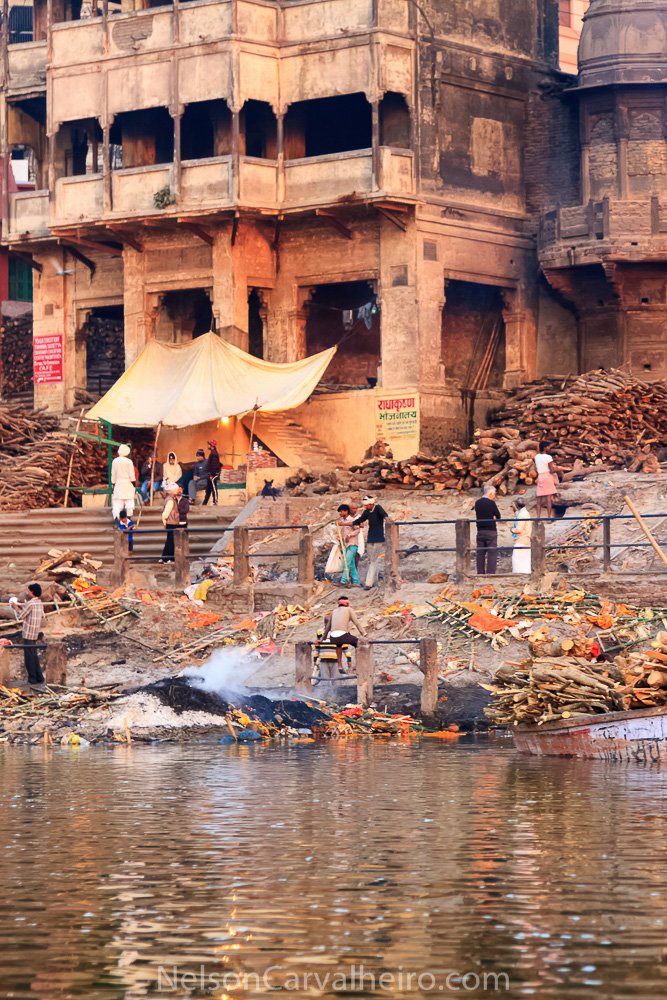
Arriving at Varanasi
The first thing you notice in Varanasi is the smell… a putrefying smell of the piles of rubbish, the cow dung, the cremations, and the dirty Ganges. It is impossible not to panic instantly and instantly think twice if it was actually worth it to make this journey. But before you even come this far, you have to endure a 1h30 ride in a dusty, pothole ridden, gravel and mud, excessively noisy and dangerous road, that leads from the airport to the Varanasi.
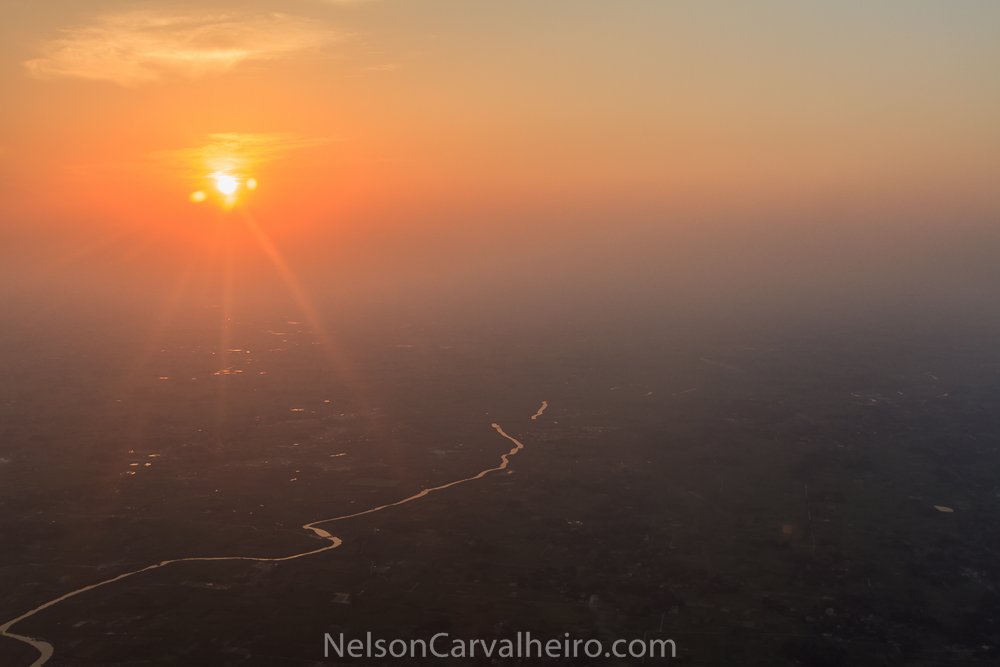
All the new airports in India were built about 1h30 drive from the city centers and Varanasi is no exception. Plus there is an ongoing attempt by the State of Uttar Pradesh and the Federal Indian Government to install basic sanitation and potable water supply in the city. After years and years of digging up and covering the piping network, the roads and streets of Varanasi are more like a dusty gravel minefield. The bottom line is that the roads are an absolute disaster.
On top of this, Varanasi, which is not a big city has over 1.2 million people, making it one of the most overcrowded cities in India…
Staying in Varanasi
When you stay in Varanasi, there are only two options.
The first: The safety, hygiene, and comfort of a five-star hotel like the Taj Nadesar Palace on the Cantonment side of the City. Bear in mind that it will take you a minimum of 1h30/2h00 each way to get into the center of Varanasi and to the cremation Ghats, namely Dashashwamedh Ghat where the “Agni Pooja” (Worship to Fire) daily evening rituals. N0 matter if you are either in a cycle rickshaw, auto rickshaw or private car, the congestion is that bad. My suggestion is to do like I did and hire a boat to watch it from the water. You have a better view anyway.
The second: Do you do like me and book the Suryauday Haveli at Shivala Ghats right on the banks of the Ganges. The property is an old haveli which belonged to the royal family of Nepal. Of course there are plenty of options for Ganges waterfront hotels, but honestly, this is the one where you will have minimum comforts – this coming from someone who only stays at luxury hotels when he travels.
What is the problem with the other hotels, that makes the Suryauday Haveli look so great: it doesn’t have monkeys breaking into your room, there are 24 reception and room service, there are 2 guards at the door 24h, the food is quite good, the rooms are quite generous in size and properly cleaned every day and the property is well maintained. For as ridiculous as it may seem, they actually answer emails and there is a genuine interest in your wellbeing as a guest. Think this is too much – just have a look at the other options by the Ganges – I might be better sleeping with the water buffaloes.
Touring Varanasi
I arranged a two-day bespoke private tour with Groovy Tours, and let me tell you that, next to the hotel it was the best decision I made when visiting Varanasi. If you plan on discovering Varanasi on your own, you will have a bad time. There are no signs, English is not widely spoken, and some streets are so narrow that you can’t even see daylight, plus it all makes sense when it is subject of interpretation, explanation, and context.

If you don’t know anything about Hinduism, who is Shiva or Hanuman, what an Ashram is, a Sadhu or the difference between which flower offering corresponds to which God, you are just wasting your money and making a fool out of yourself. So, listen to my advice and get a guide. With Groovy Tours we were appointed Amrit as our private tour guide and we loved him. First of all, he is a very well educated and literate Hindu, who can easily find context connotations with traditions and customs of the western world. He doesn’t just talk to you about the history and the facts, he sits down and tells you the stories and legends behind the mythology in a most engaging manner. He took us to some pretty unknown and “private access only temples” and I can only thank him for all his dedication into making our experience as personal and valuable as possible.

Special note: always get a guide everywhere you travel in India! It will make your life much easier, believe me! You will not be subject to so much intense eye contact or personal space abuse, especially if you are a girl. Not to mention the time you waste in searching for the significance of a temple in a bland lonely planet guide.
Sunrise and the holy dip in the Ganges
It’s never really silent in Varanasi! There is always some kind of noise happening, but not like in a modern city. It is a different kind of noise, more real and significant. As if somewhere close, there is always someone praying or doing some holy ritual.
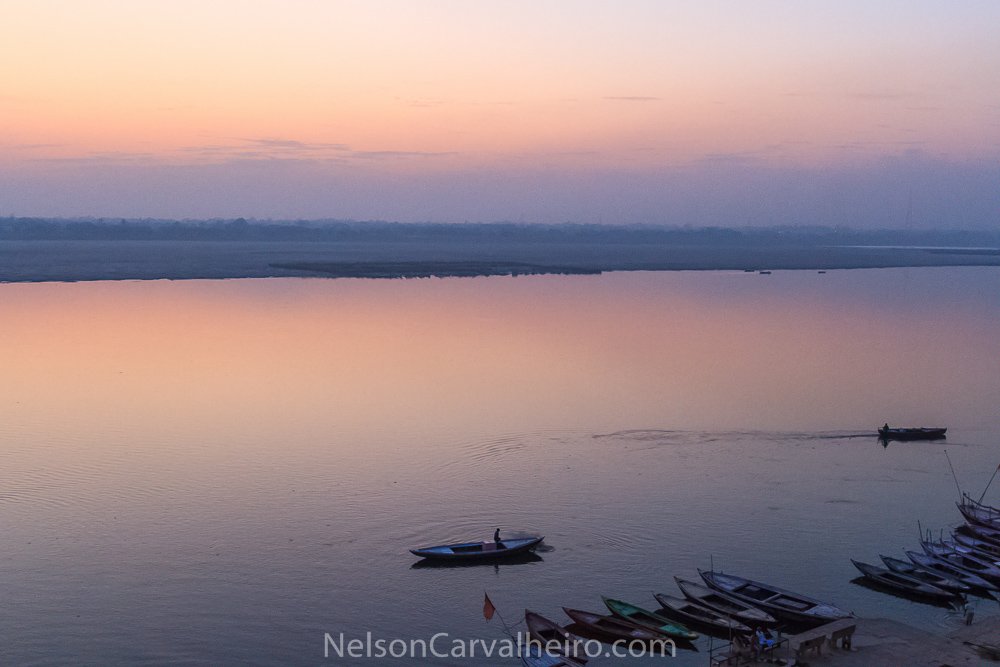
At 5h30 in the morning (we traveled in March) as the dawn starts to cast a reddish hue on the mirror-like surface of the Ganges, the morning prayers, rituals and salutations begin. Full blast loudspeakers, one for each Ashram, spread music played in honor of the sun. When you are facing the river from the Varanasi side, the Ganges flows to your left and this was the direction we took on our 6h00 Sun Salutation Tour.
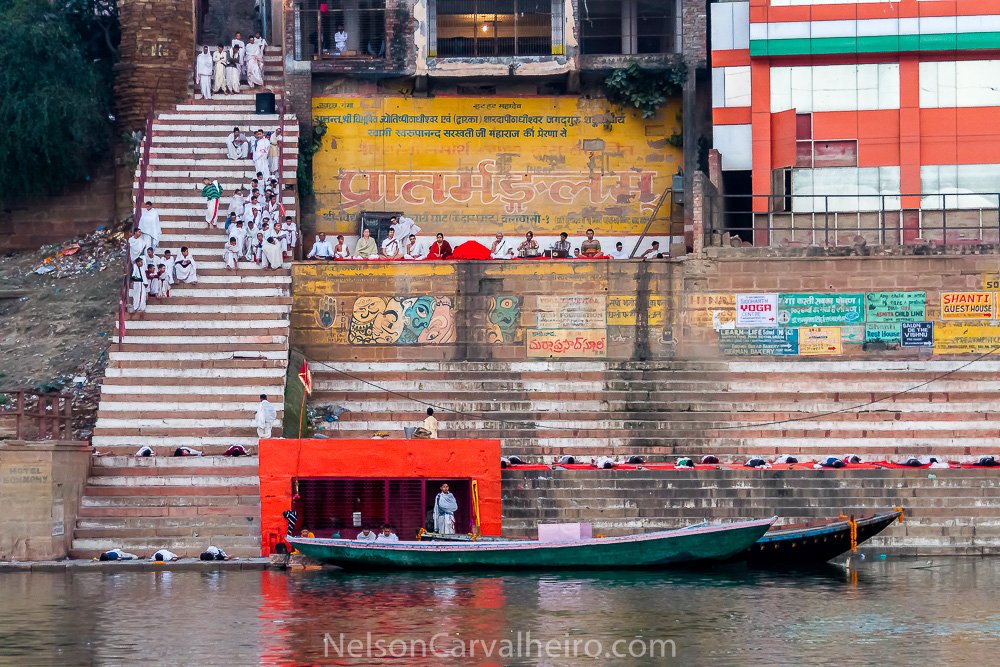
At the tip of Shivali Ghat (where the Suryauday Haveli is located) a raggedy old boat and his proud rower were waiting for us. In Varanasi, the caste system is very important in the Tourism sector and unless you come from a family of a boatman, you will never stand a chance to own your own boat.
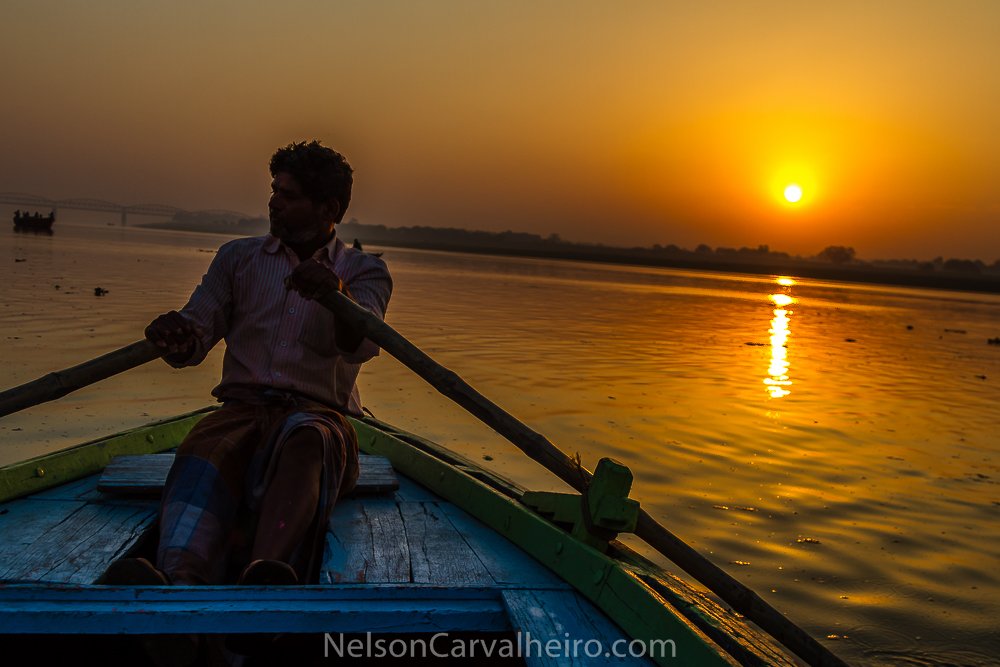
It is quite astonishing to see the margins of Varanasi in this light. If you are a photography lover this is the absolute best time to photograph the city. On one side Temple after Temple, Ashram after Ashram, Royal Palace after Royal Palace…in red, white, blue, orange, yellow…On the other a vast emptiness of marshland just waiting for the next monsoon season.

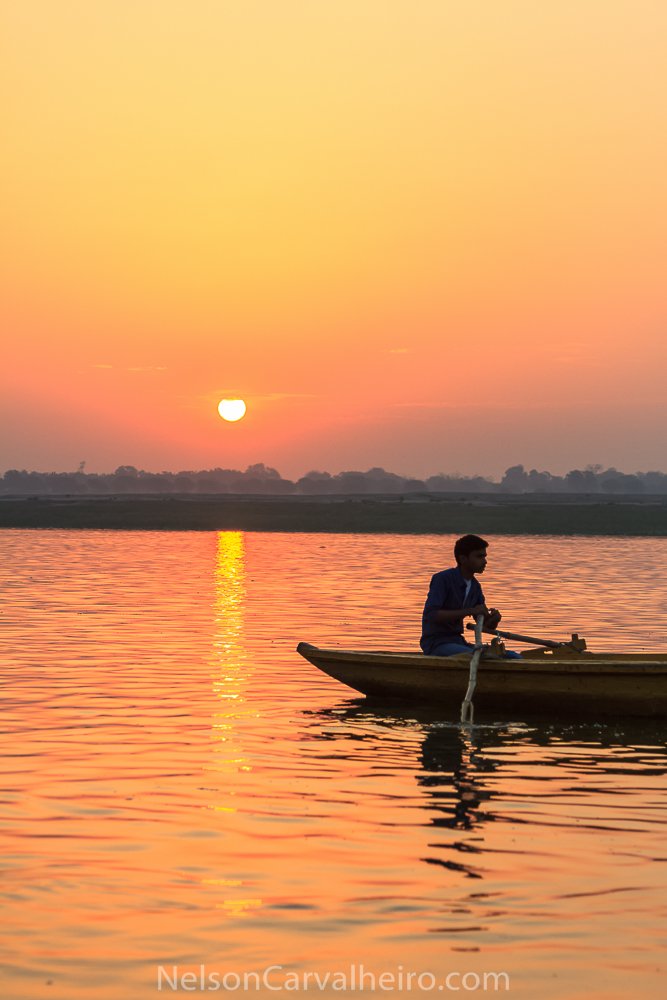
The gentle strokes on the water ripple the mirror of the Ganges as if it was coordinated with the music and city’s awakening to yet another day. We make our descent downriver, one can admire the spectacle of a few perform the sun salutations and the holy dip, others are already washing clothes, others just washing themselves. Some very candid moments in such an intense city. Hindus believe that the touch of Ganga (their name for the Ganges) cleanses one of all sins and taking a dip in the holy Ganga bestows heavenly blessings.
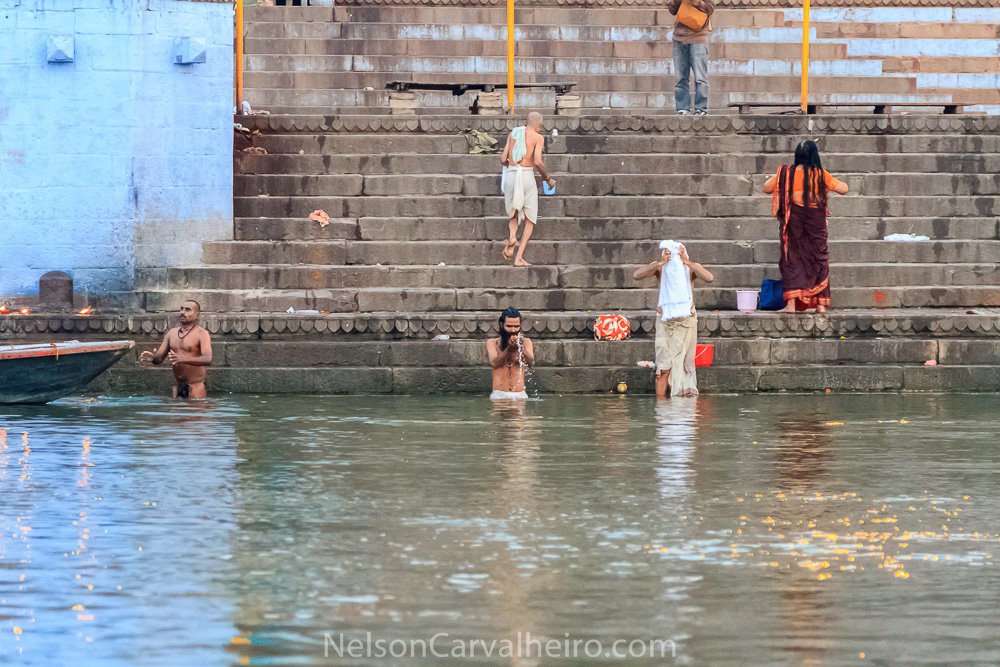
Being conscientious of the dangerousness and fear of as much as having a splash of water touch my skin, I tend to sit steadily on the boat without making any sudden movements. I know how polluted and filled with bacteria this water is. I have heard the stories about the infections and how many tourists get bedridden in pain for days just from touching it. At the same time, I see these people, children, young women, old men, all diving into the water and even drinking it. How can it be possible that they don’t get sick? Is their immune system made of steel?

Amrit laughs at how “uptight” I am. He explains that the Ganges is like a mother to the whole of India, and “How could your mother ever harm you. It’s her job to protect you and you should not be afraid of her.” He continues to say that his own mother gets automatically ill from not diving in the Ganges on a regular weekly basis.
Hinduism last rites and the pollution of the Ganges
As we were rowing down the river, we pass by a rotting corpse which is just floating adrift…The intensity of the smell from the decomposing flesh was already forecasting its approach, and at this encounter was quite unbearable. The body belonged to a Sadhu because the white virgin silk which still covered a portion of the body. According to Amrit, the body was only a few weeks old, and a recording side effect of the increased pollution which deprives the Ganges of aquatic life.

You see, according to Hindu tradition, your body must be cremated in order to cleanse your passage to the next life, hence the cremations Ghats for which Varanasi is so known for (more on this further in the article). However, Sadhus are a part of the 5 (five) kind of persons who are not be cremated upon its death, because a symbolic cremation is already part of becoming a Sadhu. The other 4 are: A pregnant woman, because it is unholy to take two lives at the same time; someone who was bitten by a snake as snakes are a manifestation of Lord Shiva and when their bite kills someone, the person is not considered dead because he has achieved immortal life in another world; young children, because the souls of children are not bound to the body too long to get attached to the body; and lepers, as the cremation grounds are places of public gathering and this way the chance of spreading the disease is much lower.

Our boatman gently swerves the boat to avoid bumping into the corpse and everyone on board says a small prayer: Om Shivaya Namah – Praise lord Shiva.
The fact of the matter is that Hindus have been putting corpses and the ashes of cremations in the Ganges for millennia. It is just that now there are over 1,3 billion of them, with the cities neighboring the Ganges becoming increasingly overpopulated. Until the rule of the British (19th and 20th century), there was no direct sewage to the river, and when they introduced it the levels of pollution have constantly increased. Just to give you an idea, one drop of water from the Ganges (outside of the monsoon) contains 1.5 million e-Coli bacteria! 3000 times the level considered safe by the W.H.O (world health organization). A result of the putrefying corpses, the urban sewage, and industrial waste.

As a part of the last rites ritual, the corpse is wrapped in white virgin silk and tied with stones so the body can be dragged to the bottom of the river. Before the pollution and the overpopulation, the Ganges was with filled with aquatic life, namely turtles and crustaceans which would naturally process the corpses until there was no remain left. Nowadays that aquatic life is shallow in numbers and this process takes longer and longer to happen. Most of the times these ropes break and the bodies come afloat.
Naturally, Mother Nature has its own way to cleanse the river. This his happens every monsoon season. At this time the water level rises dramatically and the current speed as well. This helps to drag all the remains downstream and to renew the river’s fauna and flora. The only problem is that dams, bridges and the narrowing of the river are making it increasingly difficult for this cleansing process to happen each year. This lead to the creation of the so-called secondary cremation Ghats downriver, where the corpses which have come afloat and washed on shore can be disposed of, instead of being eaten by the stray dogs in plain sight…Yes, I witnessed this in front of my eyes…
Sun Salutation Rituals at Panchganga ghat
We pass the smoldering cremations of Manikarnika Ghat, next to Dashashwamedh Ghat. The ashes of about 5 cremations are still smoldering as the first rays of light hit the city. You can see the wood for burning stacked almost as high as the temples as if they were getting ready to cremate an army. Floating single candles with flowers are still bouncing above the now more active waters.
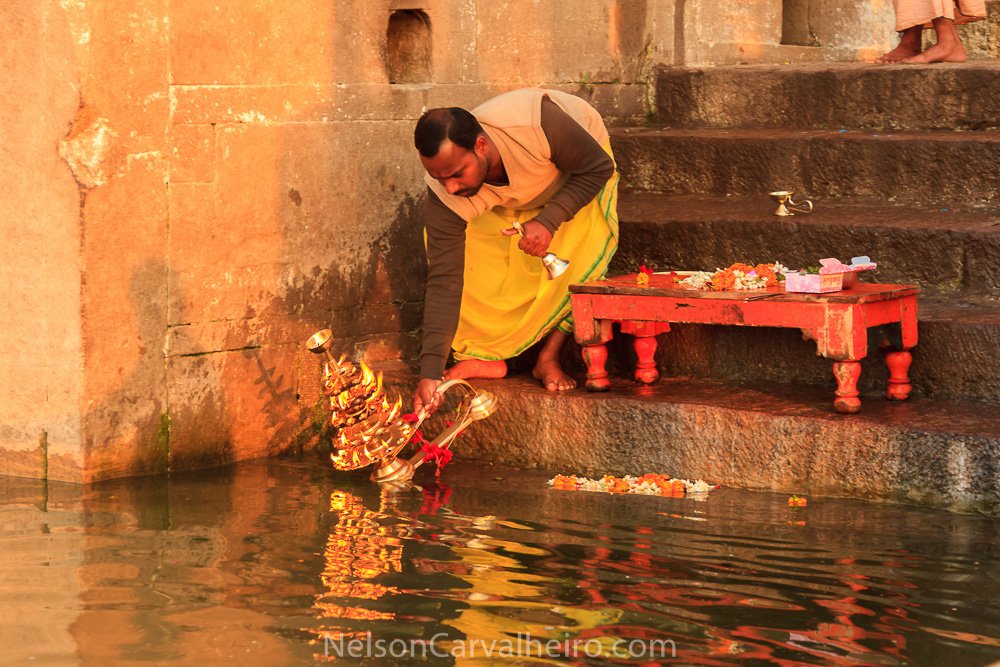

We pass the leaning temple of Varanasi (Yes they have one too), to arrive at the place where a group of men is starting their sun salutation ritual. The golden light just adds to the intensity of the moment. He has a bell in his hand, which he continuously tolls. The 5 level candle is swung backward and forwards as the words of prayer to the Sun God are spoken out in an almost state of trance. Soon others join him to make a small orchestra to the rising Sun. Flowers are put on the river as a tribute to the God. Just next to this very intense religious ceremony, a group of young men comes to a rather fun holy dip. The Sadhus in the background are watchful keepers of the practice and pretty soon the ghat is full of people chanting and tolling bells, pan and more.
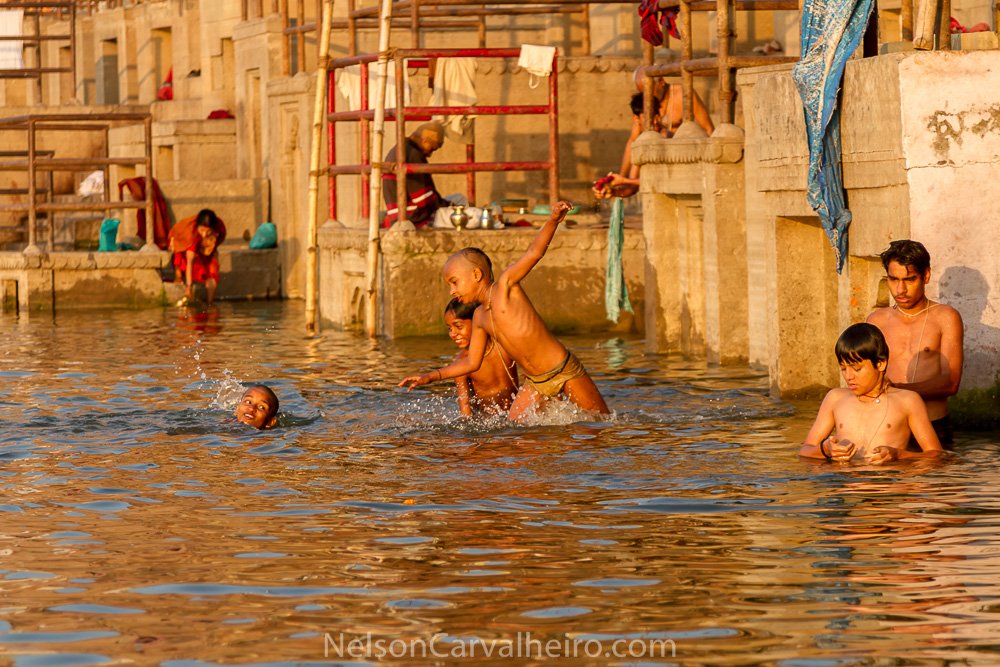


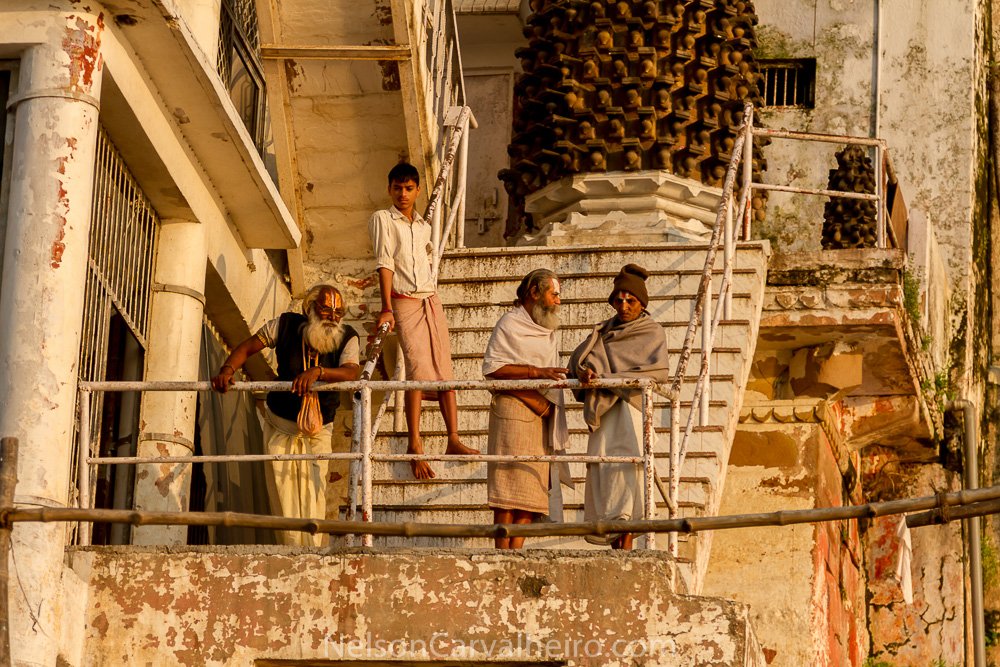

Start walking at Vijaya Nagaram Ghat
The second part of the morning tour took place on foot. We disembarked our flimsy little boat, not before thanking our “captain” for his heroic effort of ferrying us upstream with only the power of his arms. Considered as one of the main Ghats of Varanasi, the Vijaya Nagaram Ghat is easily recognizable by its red and white striped pavement and by the Nilakantha and Nispapesvara temples who lay above it. More interestingly are all the Holy Men, Gurus, Sadhus, and Hindu priests who are performing blessing and spiritual “cures” to their devotees. Each man has his own allot space in this Ghat, sometimes just a meter wide, but enough for all the needed spirituality.
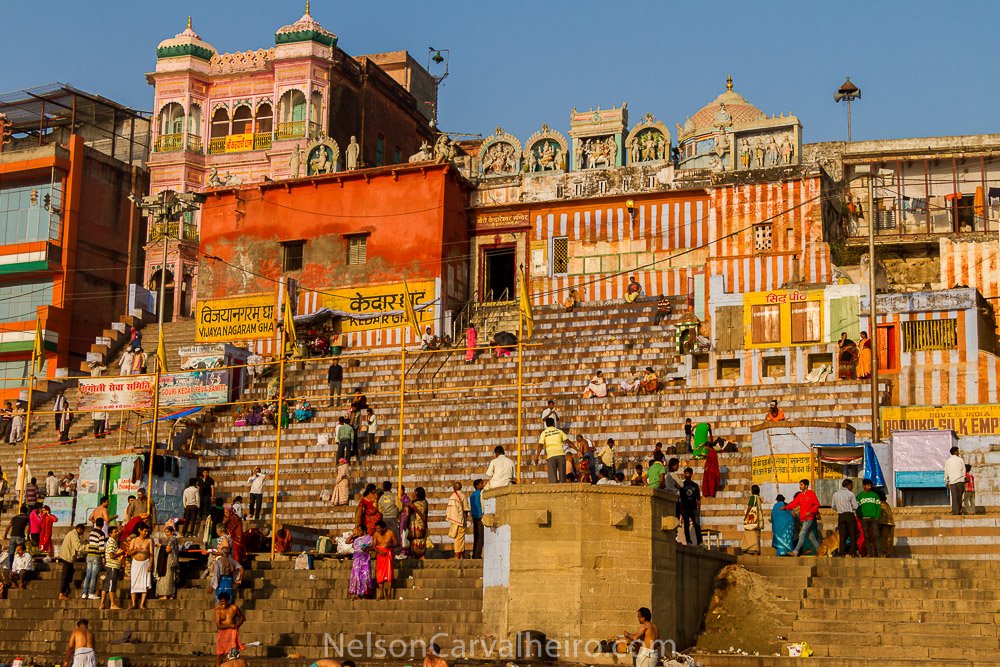
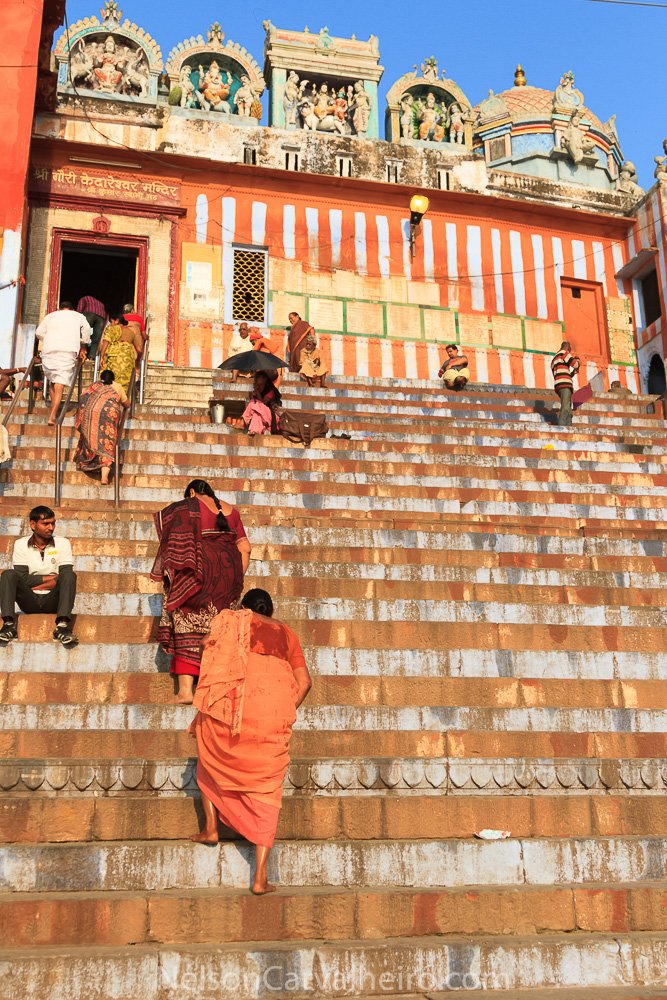

We spend around two hours walking in the old city. The idea was to explore the cultural diversity of Varanasi, visit an Akhada (traditional Hindu gym) and the oldest alive site in the whole of Varanasi. We also visited The Money Temple (second most important and most visited temple of Varanasi), Vishwanath temple situated at BHU (Banaras Hindu University) and an Ashram where holy men live to learn more about their mysterious life.
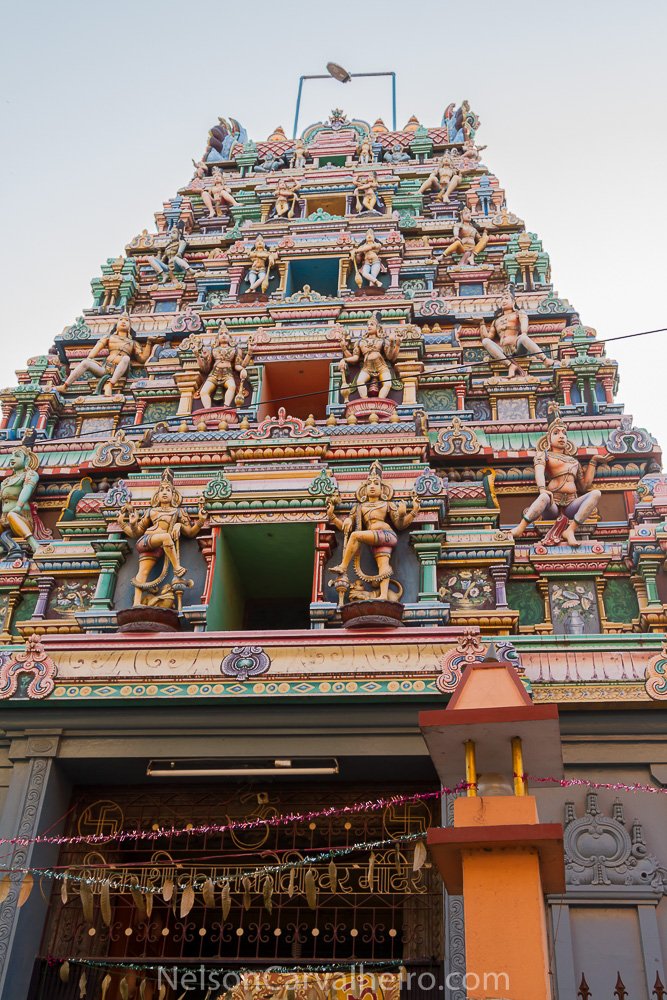
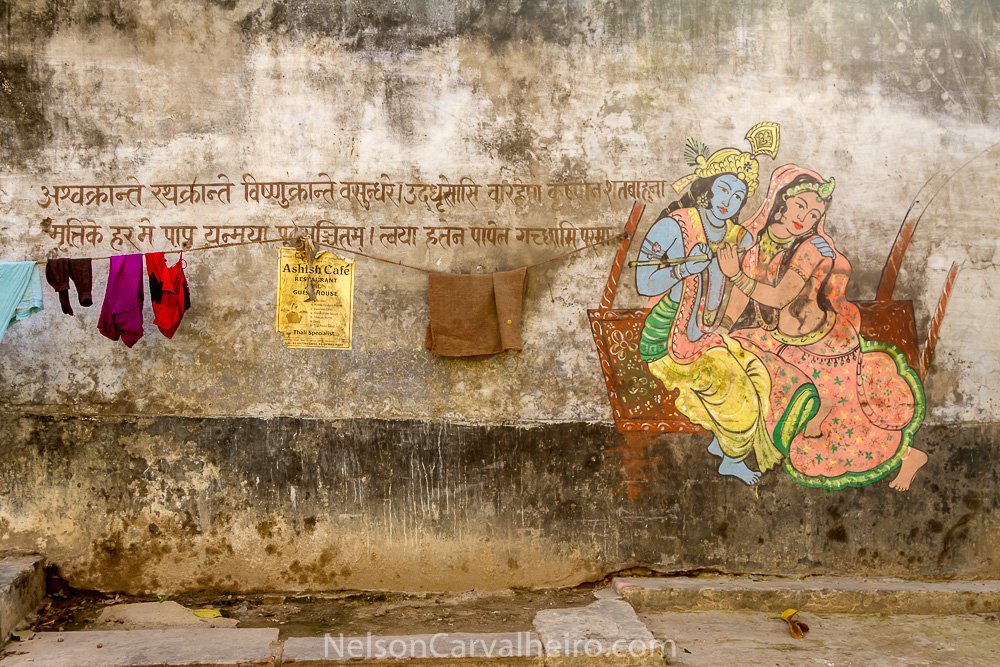

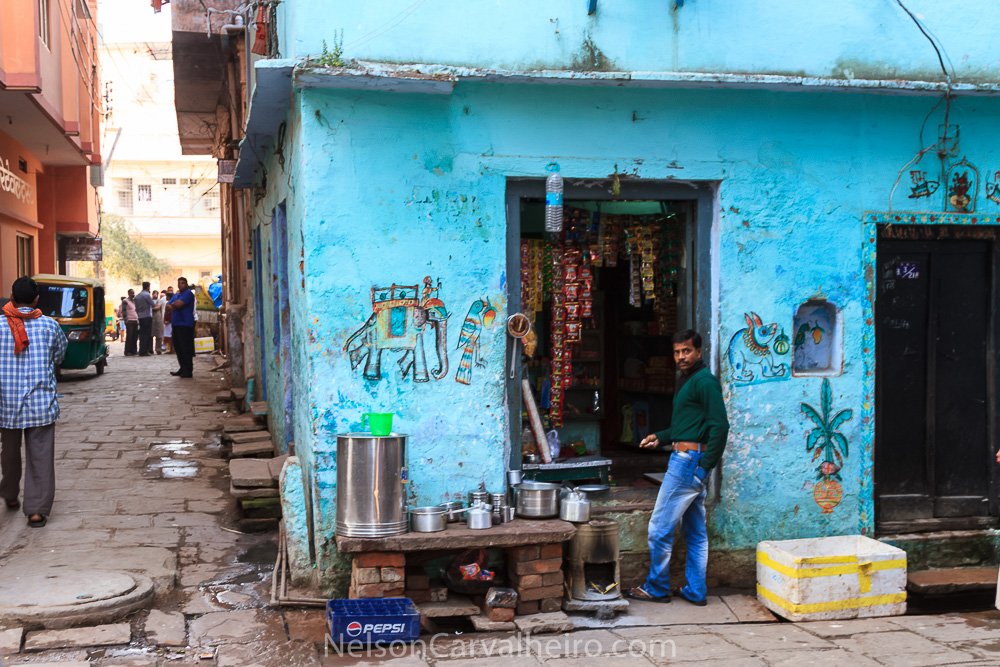
After lunch, we went walking around in the northern part of the old city to explore the area around Golden temple (most important cultural, religious and commercial area of Varanasi) and further North which is the oldest alive area of Varanasi. We were walking in extremely narrow and maze alleys of the northern part of the city. As I mentioned before, some of these streets are so narrow that at the peak of the day we could have used a flashlight to see the way. We probably walked by 1000 temples, as most of them are privately held in people’s residencies. Others are simply a hole in the wall with some saffron paint over a shapeless figure, intended to honor Lord Vishnu.


Since the 2010 Varanasi bombings security around the Golden Temple is provided by the Indian military. The Golden Temple is Varanasi’s most important temple, dedicated to Lord Shiva naturally and shares ground with a mosque. All the entrances and exits, all alleyways and small paths are manned by 3 or more soldiers armed with AK-47 and bulletproof vests. No photography is allowed on these streets and admissions to the temple need to be requested to the local authorities.

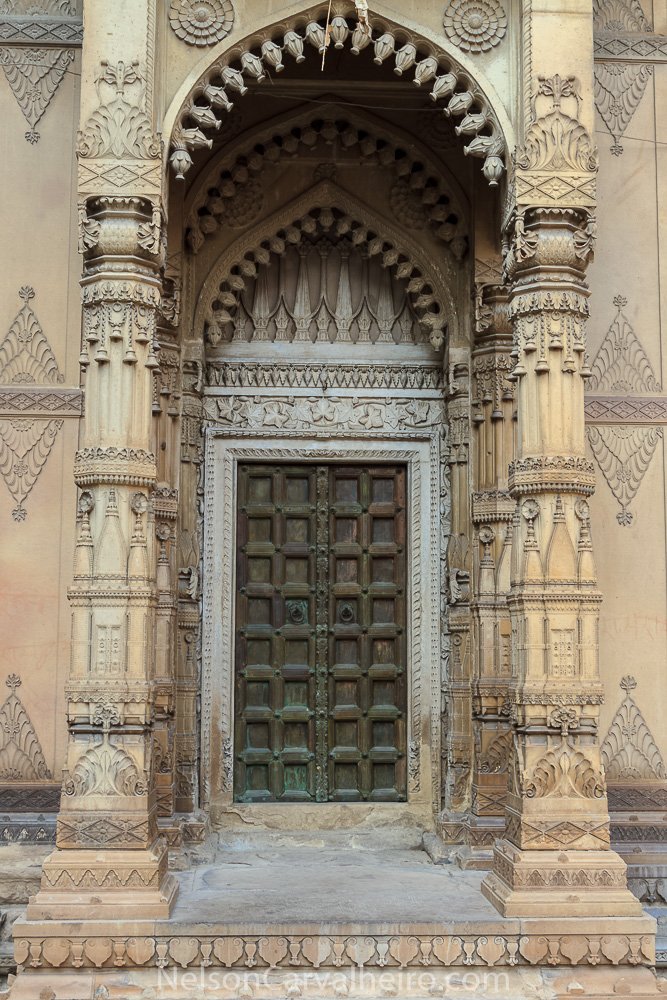



Even though it was profoundly confusing, this center of the northern part of Varanasi is filled with different temples, old buildings, mosques, bazaars, palaces, and several other hidden but beautiful and interesting places. Amrit tells us that the Mughal emperors continuously raided and destroyed Varanasi, in an attempt eradicate Hinduism heritage and religion from this area.
After the Alamgir Mosque, we went down some narrow steps into the end of our journey in Varanasi to witness the cremations at Manikarnika Ghat and the “Agni Pooja” at Dashashwamedh Ghat.
Manikarnika Ghat, the biggest cremation ghat in Varanasi
It is not uncommon to see muslin-wrapped bodies being carried through town and down to the river, placed on a funeral pyre and cremated in full public view. This unlimited access to the practical applications of the Hindu faith, the raw intimacy with death and the stifling intensity of the narrow lanes that lead down to the holy river often combine to leave visitors literally breathless, emotionally overcome but never unmoved, or unimpressed. Hindu mythology teaches that the ghat is especially sacred and that persons cremated there receive moksha.

In keeping with the Hindu custom of swift cremation, bodies are cremated within 24 hours after death, if at all possible, or at the very latest before sundown on the next day if death occurs late in the afternoon. Normally the eldest son carries out the funerary rites. He lights the funeral pyre after first placing a burning stick in the mouth of the deceased. There is little mourning when a Hindu dies because they believe that once a person is born he or she never dies. Often there is little crying. Some Indians have said this is because the point of a funeral is to show respect, not sadness. Other say it is because Hindu believe the dead are off to a world far better than the one they left behind.
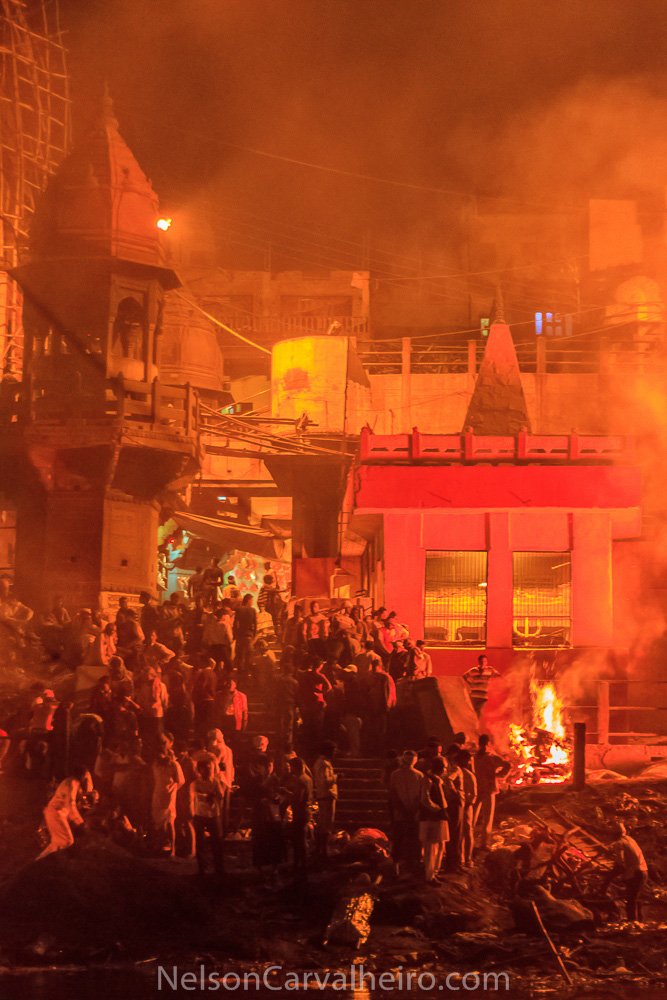
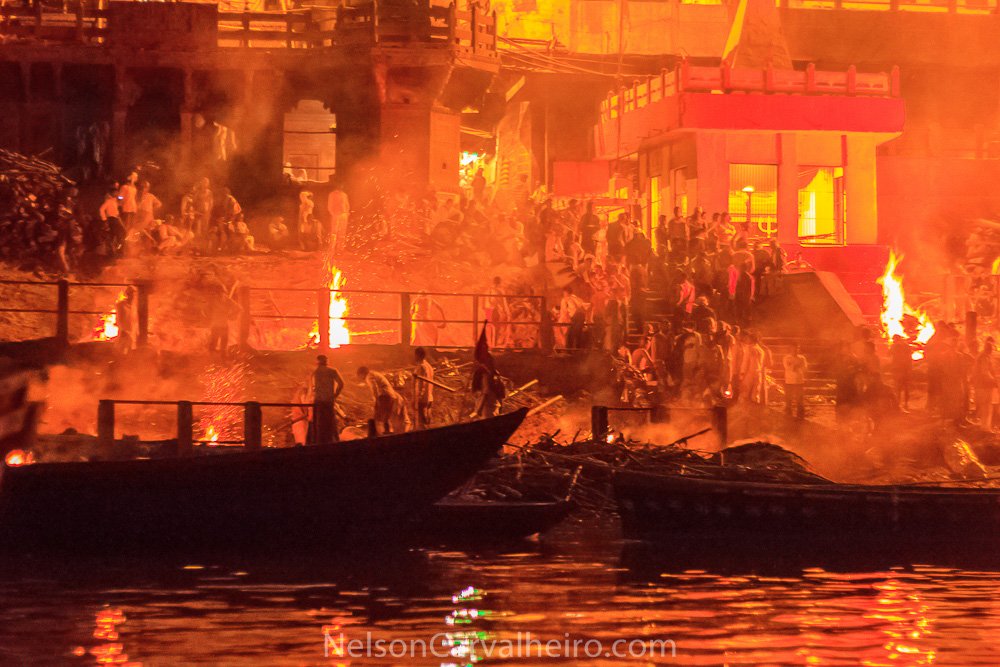



Traditionally women have not been allowed at cremations because they might cry.
The view is quite Dantesque as if we were facing a medieval paint of what hell would be like. The rising flames are about 7 meters tall and the music in the background make this nothing more than an apocalyptic sight of things. Each funeral has its own entourage gathered around the deceased as they wait for their turn to be cremated by the Ganges. From where I am sitting I count about 10 burning burial mounts and another 10 or 15 waiting for their turn. If there was any crying by the friends and family members, it was certainly unheard as the loud bell ringing and loudspeaker thumping of the nearby “Agni Pooja” completely overwhelms the ears. As if the sight and smell were not already on overdrive…
I think for me the most surprising and most shocking was hearing someone’s explanation about how “It’s like when you are roasting a chicken, They have to turn the body a few times to get it evenly cremated until there nothing left but ashes!”.
After the cremation, the bones and ashes of the deceased are thrown into the Ganges and Moska was reached for this aatma
PS: I think this water buffalo grew fond of me
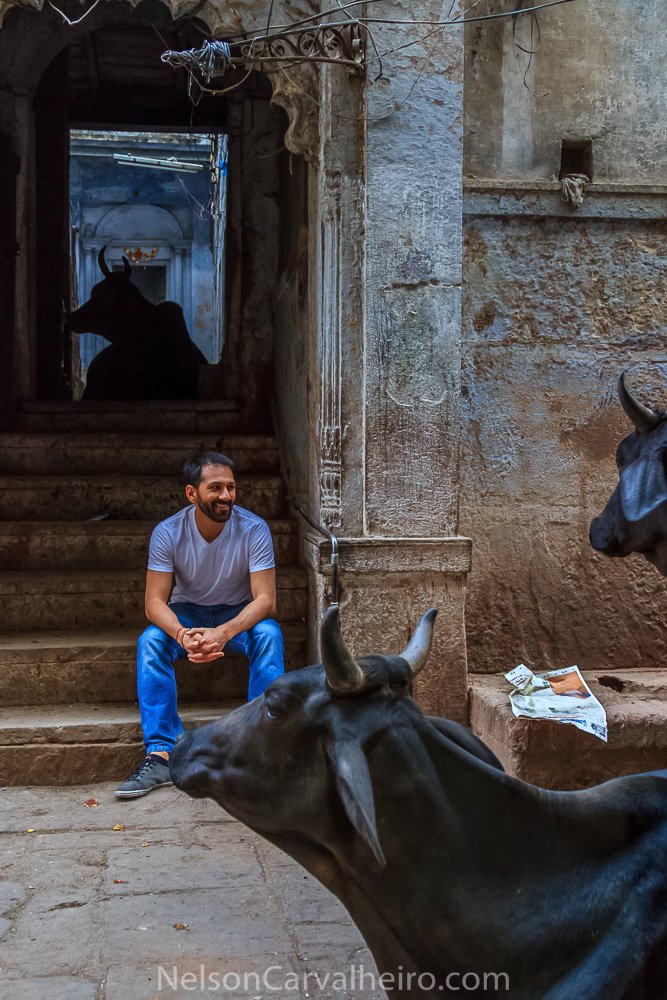
6 Comments
Add comment Cancel reply
This site uses Akismet to reduce spam. Learn how your comment data is processed.




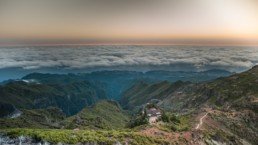
Hi Nelson! I loved your article about your experience in Varanasi! Congrats! I had no idea of the cremations and it must have taken you a lot of courage to assist to the entire process… But I think you found it worthy, didn’t you? And I enjoyed seeing your smile in the last photo 🙂 Well, of course I ADORED all the photos. Thank you for your view in words and images of such a different world from the one we live in, alltough they are in the same strange planet.
Anyway, since I’m not in India, but adore colors like the ones you publish here, maybe you would like to take a break from such strong emotions and take a peek at a some wonderful camelias that you can find in an historical garden next to the Oporto Wine cellars in Gaia city. Hope you like them 🙂
Hi Vera. Thank you very much for your comment, and thank you for the flowers. Yes, Varanasi is still today the most intense travel experience that I had and something that I refer back to time and time again.
Love it, some really amazing pictures. Definitely on my bucket list.
Thank you Stefania. Yes, Varanasi is the ultimate change your perspective on the world location.
Great article. Every word of it is true. Your explanation on cremation is something really philosophical. I took a tour with http://www.tourvaranasi.com/ in the month of Jun’16. Although it was very humid and warm but i thoroughly. Planning to visit again to Varanasi in Jan’18 and will spend more days to cover all you have explianed about. More to it going to read all of your articles.
First thing GREAT photo’s just those told the story, I loved how you captured the locals in their surroundings, this is truly a special place I was only in Varanasi for 2 days wish it could have been more! This was really inspiring.